
The ISCRR Research Impact Showcase hybrid event was held on Thursday 9th February 2023. It was a great success with close to 200 attendees joining us either in person or via live stream.
The event commenced with opening addresses by Colin Radford (Chief Executive, WorkSafe Victoria), Professor Doron Ben-Meir (Deputy Vice-Chancellor (Enterprise and Engagement) and Senior Vice-President, Monash University) and ISCRR’s then Director, Samantha Barker.
Research impact presentations showcasing ISCRR research and how that research led to evidence-informed decision making followed. Videos of each session, the event program with speaker profiles and slide packs are available to view on the event webpage.
Grace Norrie (CPSU Victoria) and Carmen Schroder (ISCRR) discussed how vicarious trauma is now being acknowledged as a significant workplace risk in the Victorian public service pilot sites where ISCRR research was conducted. This has led to more discussion and awareness of vicarious trauma, as well as the beginnings of implementing effective controls to prevent it.
“I just think it being in the forefront of our minds at the location… has helped open up that conversation and made it less taboo.”
Pilot site research participant
Melinda Rice (WorkSafe Victoria) and Dr Sarah Oxford (ISCRR) outlined ISCRR’s evaluation of WorkSafe’s pilot programs: The Clinical Hotline and The Clinical Review Panel. They discussed the co-design approach of the Program Logic methodology to establish an evaluation framework, which led to a Rapid Evaluation. Societal impacts were identified as a result:
“We did see a significant change in the treatment pathway, so a change in that more evidence-based treatment from our discussions with our clinicians… [we saw] an improvement on return to work status in both the pilots as well”
Melinda Rice, WorkSafe Victoria
Inhaling the fumes from laying hot bitumen in road construction can cause significant health impacts for road workers. The industry switch to the use of warm-mix asphalt technology in road construction, which lowers the fume volume, was just one of the societal impacts that resulted from the ISCRR research that Dr Janine McMillan (ISCRR) and Nick Blackford (Australian Workers’ Union) discussed.
“The [ISCRR] study identified that not only was there no standardised testing across the industry… there were some compounds identified that not everyone was testing for….”
Nick Blackford, Australian Workers’ Union
Nick noted that as a result of ISCRR’s research, a standardised testing method is now being developed to identify hazardous compounds in the bitumen, creating safer, more consistent monitoring practices across the industry.
To finish the event, Professor Sharon Newnam (QUT) and Dr Natassia Goode (WorkSafe Victoria) covered their research into systems thinking approaches to preventing health and safety risks in the workplace.
Professor Newnam detailed the pilot use of the Systems Thinking Incident Review (STIR) Tool and how it helped identify trends that influenced workplace health and safety incidents, especially at higher levels of the system.
“We can’t just look at controls at the lower levels of the system, we need to be looking at actions up higher.”
Professor Sharon Newnam, QUT